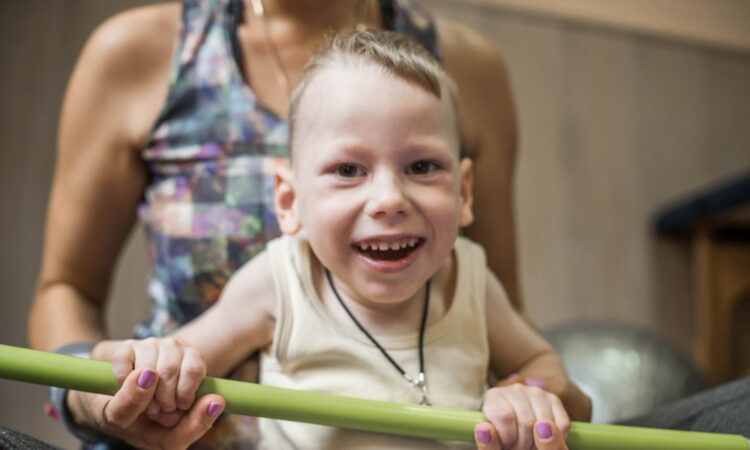
Defining Erb’s Palsy: A Neurological Perspective
Erb’s Palsy is a condition that stems from an injury to the brachial plexus, the network of nerves that sends signals from the spine to the shoulder, arm, and hand. This type of injury typically occurs during childbirth when the baby’s neck is stretched to the side, affecting the upper arm’s functionality.
The severity of Erb’s Palsy can vary, with some individuals experiencing mild weakness while others may face complete paralysis in the affected arm. The condition is characterized by several neurological symptoms:
- Loss of sensation in the arm
- Partial or total paralysis of the shoulder or elbow muscles
- Weakness in the arm, leading to difficulty with grip
- Decreased motor function in the affected limb
Early diagnosis and intervention are crucial for improving outcomes. A multidisciplinary approach involving neurologists, pediatricians, and therapists is often recommended to address the complex needs of those with Erb’s Palsy.
The Impact of Erb’s Palsy on Motor Functions
Erb’s Palsy primarily affects the arm’s motor functions due to nerve damage in the brachial plexus. This condition can lead to a range of motor deficits that vary in severity depending on the extent of the nerve injury. The most common manifestations include:
- Weakness in the arm, which may range from mild to complete paralysis.
- Loss of sensation, resulting in an inability to feel touch, heat, or cold.
- Reduced fine motor skills, making tasks such as buttoning a shirt or writing challenging.
- Impaired gross motor skills, affecting larger movements like lifting or carrying objects.
Individuals with Erb’s Palsy may experience difficulty in performing everyday activities, which can be both frustrating and limiting. The degree of motor function impairment also influences the type of therapy required. For instance, those with milder forms of Erb’s Palsy may benefit significantly from physical therapy, while severe cases might necessitate surgical intervention. Early and consistent therapeutic interventions are crucial in improving motor functions and enhancing the quality of life for those affected by Erb’s Palsy.
Psychosocial Considerations for Affected Individuals
The journey of individuals with Erb’s Palsy is not limited to physical challenges; it encompasses a range of psychosocial aspects that merit attention. The condition can significantly influence a person’s self-image and social interactions, often leading to feelings of isolation or difference, especially in children and adolescents.
Key considerations include:
- Social Development: Children with Erb’s Palsy may experience difficulties in making friends or participating in group activities, which are crucial for social development.
- Emotional Well-being: The frustration of physical limitations can lead to emotional distress, anxiety, and depression.
- Self-esteem: Coping with a visible physical difference can impact self-esteem and body image, particularly during the formative years.
Support systems play a vital role in addressing these psychosocial challenges. Family, friends, and support groups can provide the necessary emotional scaffolding. Additionally, counseling and therapy can help individuals develop coping strategies, enhancing resilience and promoting a positive outlook on life.
Traditional Therapeutic Approaches for Erb’s Palsy
Physical Therapy: Techniques and Goals
Physical therapy stands as a cornerstone in the management of Erb’s Palsy, aiming to improve joint mobility, muscle strength, and overall function. The primary goal is to prevent joint stiffness and muscle atrophy, which can occur due to the lack of movement in the affected limb.
The techniques employed in physical therapy are diverse and tailored to each individual’s needs. A typical regimen may include:
- Gentle stretching exercises to maintain joint flexibility
- Strengthening exercises to build muscle tone
- Range-of-motion activities to enhance joint mobility
- Neuromuscular re-education to improve coordination
Therapists also educate parents and caregivers on how to continue exercises at home, ensuring consistent progress. The success of physical therapy often hinges on early intervention and the commitment to a regular exercise routine.
Occupational Therapy: Enhancing Daily Functionality
Occupational therapy plays a crucial role in the management of Erb’s Palsy by focusing on improving the patient’s ability to perform daily activities. This form of therapy is tailored to the individual’s needs, aiming to enhance their quality of life and independence.
The occupational therapist begins by assessing the patient’s functional abilities and the severity of the limb involvement. Based on this assessment, a personalized treatment plan is developed, which may include:
- Exercises to improve fine motor skills and hand-eye coordination.
- Techniques to facilitate self-care tasks such as dressing, eating, and grooming.
- Adaptive strategies and the use of assistive devices to compensate for limited arm mobility.
Therapists also work closely with families to integrate therapeutic activities into the patient’s daily routine, ensuring consistent practice and progress. The ultimate goal is to enable individuals with Erb’s Palsy to navigate their environment with greater ease and confidence.
The Role of Surgery in Severe Cases
In instances where traditional therapies do not yield the desired improvements in Erb’s Palsy, surgery may be considered as a viable option. Surgical interventions are typically reserved for severe cases where there is a lack of functional recovery or when there is an avulsion injury, where the nerve roots are torn from the spinal cord.
The primary surgical techniques include:
- Nerve Transfers: Surgeons may graft nerves from other parts of the body to restore function to the affected arm.
- Nerve Grafting: This involves replacing damaged sections of the brachial plexus with sections of nerves taken from other areas of the patient’s body.
- Muscle Transfers: In some cases, muscles may be moved from other parts of the body to the affected limb to improve movement.
The timing of the surgery is crucial, with the best outcomes often achieved when performed within the first year of life. Post-surgical rehabilitation is essential to maximize the benefits of the procedure and typically involves a combination of physical and occupational therapy to enhance recovery and functionality.
Innovative Non-Invasive Treatments
Constraint-Induced Movement Therapy
Constraint-Induced Movement Therapy (CIMT) is a form of rehabilitation that encourages the use of the affected limb by restricting the movement of the unaffected limb. This technique is based on the principle of neuroplasticity, which is the brain’s ability to reorganize itself by forming new neural connections.
The therapy typically involves several key steps:
- The unaffected arm is constrained in a sling or a glove, compelling the patient to use the affected arm for daily activities.
- The patient engages in repetitive and task-oriented activities that are designed to improve motor function in the affected limb.
- Therapy sessions are intensive and can last for several hours a day over a period of weeks to maximize the potential for neurological recovery.
CIMT has been shown to improve the quality of movement and increase the range of motion in individuals with Erb’s Palsy. It is most effective when started early and can be adapted to suit the needs of patients of different ages.
Electrical Stimulation as a Therapeutic Tool
Electrical stimulation therapy has emerged as a promising non-invasive treatment for individuals with Erb’s Palsy. This technique involves the use of electrical currents to stimulate muscle contraction and promote nerve regeneration. The therapy can be particularly beneficial in improving muscle strength and function, which are often compromised in those affected by Erb’s Palsy.
The process typically includes the following steps:
- Assessment of the patient’s condition and identification of target muscles.
- Placement of electrodes on the skin over the affected muscles.
- Careful adjustment of the electrical current to achieve optimal muscle response without discomfort.
- Regular sessions that may gradually increase in intensity as the patient’s condition improves.
Patients have reported improvements in both range of motion and motor control after undergoing electrical stimulation therapy. Moreover, when combined with traditional physical therapy, the results can be significantly enhanced. It is important for patients to consult with healthcare professionals to determine the most appropriate treatment plan. The therapy’s accessibility is also a key advantage, as it can be administered in clinical settings or at home with portable devices.
Hydrotherapy: Benefits of Water Exercises
Hydrotherapy, also known as aquatic therapy, involves the use of water exercises to improve the range of motion, strength, and functional abilities in individuals with Erb’s Palsy. The buoyancy of water reduces the effects of gravity, allowing for easier and less painful movements.
Key benefits of hydrotherapy include:
- Decreased pain: The warm water helps to relax muscles and alleviate discomfort.
- Improved circulation: Water pressure can enhance blood flow, promoting healing.
- Enhanced flexibility: The resistance of water allows for gentle stretching of muscles and joints.
- Increased muscle strength: Water provides a natural resistance, which can be adjusted by changing the speed of movements, leading to improved muscle tone without the need for weights.
Hydrotherapy sessions are typically guided by a trained therapist who tailors exercises to the individual’s specific needs. The therapy can be particularly beneficial for children, as the playful aspect of water exercises can motivate them to engage in their treatment with more enthusiasm. As with any therapeutic approach, it is essential to consult with a healthcare professional to determine if hydrotherapy is suitable for the individual’s condition and to ensure that the exercises are performed safely.
Technological Advancements in Erb’s Palsy Rehabilitation
Robot-Assisted Therapy: A New Frontier
The advent of robot-assisted therapy marks a significant milestone in the rehabilitation of individuals with Erb’s Palsy. This innovative approach utilizes robotic devices to support and enhance the movements of the affected arm, providing a high level of precision and consistency in therapeutic exercises.
Key benefits of robot-assisted therapy include:
- Customization: The ability to tailor exercises to the specific needs and progress of each patient.
- Repetition: Robots facilitate a high volume of repetitive movements, which is crucial for neuroplasticity and motor learning.
- Feedback: Real-time feedback provided by the system allows for immediate correction and adjustment, optimizing the therapeutic outcome.
Despite its promise, robot-assisted therapy is not without challenges. The cost and accessibility of such technology can be prohibitive, and there is an ongoing need for research to fully understand its long-term efficacy. Nonetheless, for those who have access, robot-assisted therapy represents a compelling addition to the spectrum of treatments available for Erb’s Palsy.
Virtual Reality: Immersive Therapeutic Experiences
The advent of virtual reality (VR) has opened up new avenues for the rehabilitation of individuals with Erb’s Palsy. By immersing patients in a computer-generated environment, VR allows for the creation of tailored therapeutic experiences that can address specific motor deficits in a controlled and engaging way.
Key benefits of VR therapy include:
- Enhanced Motivation: The gamified nature of VR exercises increases patient engagement and motivation, which is crucial for long-term therapy adherence.
- Safe Repetition: VR enables safe, repetitive practice of movements, which is essential for motor learning and neuroplasticity.
- Real-time Feedback: Immediate feedback on performance helps patients adjust their movements for better outcomes.
- Customization: Therapeutic programs can be easily adjusted to match the patient’s progress and abilities, ensuring a personalized approach to rehabilitation.
Research into the effectiveness of VR in Erb’s Palsy therapy is ongoing, but early results are promising. As technology continues to evolve, VR may become a staple in the therapeutic toolkit, offering a blend of fun and functionality that could redefine the recovery process for many patients.
Wearable Technology for Continuous Monitoring
The advent of wearable technology has opened new avenues for continuous monitoring in the management of Erb’s Palsy. These devices, often compact and user-friendly, enable real-time tracking of movement patterns and muscle activity, providing valuable data for both patients and therapists.
Key benefits of wearable technology include:
- Personalized data tracking: Patients can receive tailored feedback on their progress, allowing for adjustments in therapy protocols.
- Early detection of complications: Continuous monitoring can help in identifying issues before they escalate, potentially preventing further injury.
- Enhanced motivation: Real-time results can serve as a motivational tool for patients, encouraging them to engage more actively in their rehabilitation.
Incorporating wearable tech into therapeutic regimens represents a significant shift towards more individualized and efficient care. As these technologies evolve, they promise to further refine the approach to treating Erb’s Palsy, making therapy more accessible and effective.
Integrative and Alternative Medicine in Erb’s Palsy Care
The Efficacy of Acupuncture and Acupressure
In the realm of integrative medicine, acupuncture and acupressure have emerged as potential allies in the management of Erb’s Palsy. These traditional Chinese medicine techniques are believed to stimulate the body’s natural healing processes and improve nerve function.
Acupuncture involves the insertion of fine needles into specific points on the body, while acupressure uses gentle pressure on these points instead. Both methods aim to release blockages in the body’s energy flow, known as Qi, which can contribute to pain relief and muscle relaxation.
The following points highlight the potential benefits of these therapies in the context of Erb’s Palsy care:
- Potential to reduce pain and discomfort
- May enhance muscle strength and coordination
- Could improve range of motion and flexibility
- Offers a non-invasive alternative to conventional treatments
While the evidence supporting these therapies is still evolving, some patients have reported positive outcomes. It is important to note that these treatments should complement, not replace, the standard care prescribed by healthcare professionals. Moreover, the emergence of ‘megaverdicts’ in malpractice lawsuits underscores the critical nature of effective and safe treatment options for birth injuries.
Chiropractic Care: Aligning for Better Movement
Chiropractic care has emerged as a complementary approach in managing Erb’s Palsy, particularly with the aim of improving movement and function. This form of therapy focuses on the manual adjustment of the spine to correct misalignments, which are believed to affect the nervous system and overall body function.
The process typically involves:
- An initial assessment to determine the specific needs of the patient.
- The development of a personalized treatment plan that may include spinal adjustments, massage, and stretching exercises.
- Regular sessions to track progress and make necessary adjustments to the treatment.
Advocates of chiropractic care suggest that proper spinal alignment can facilitate better nerve signal transmission, potentially aiding in the recovery of motor functions affected by Erb’s Palsy. However, it is crucial for patients to seek care from licensed professionals who have experience with pediatric and neurological conditions. While some individuals report improvements in mobility and pain reduction, the scientific community continues to research the extent of chiropractic care’s benefits for Erb’s Palsy patients.
The Role of Diet and Supplements in Nerve Health
The nervous system requires a plethora of nutrients to function optimally, and dietary choices can significantly influence nerve health and regeneration. Essential fatty acids, particularly omega-3s, are crucial for maintaining the integrity of nerve cell membranes. Antioxidant-rich foods, such as berries and leafy greens, combat oxidative stress that can damage nerve tissues.
- Omega-3 fatty acids: Found in fish, flaxseeds, and walnuts, they support nerve cell structure.
- Antioxidants: Berries, dark chocolate, and spinach help protect nerves from oxidative damage.
- B Vitamins: Whole grains, eggs, and dairy are important for nerve repair and maintenance.
Supplements may also play a supportive role, especially when dietary intake is insufficient. B-complex vitamins, including B12 and folic acid, are often recommended to aid in nerve repair. Alpha-lipoic acid, an antioxidant, has been shown to improve nerve conduction. However, it is essential to consult with a healthcare provider before starting any supplement regimen, as interactions with other medications or conditions can occur.





